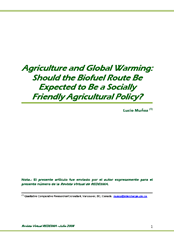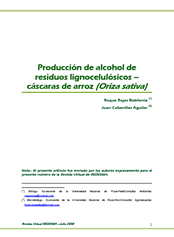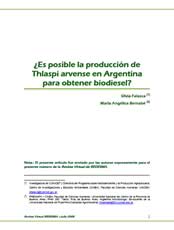Titulo: Agriculture and Global Warming: Should the Biofuel Route Be Expected to Be a Socially Friendly Agricultural Policy?
Autor: Lucio Muñoz
Resumen:
 It is now widely accepted that we need to deal with global warming issues immediately by greening production activities and by shifting from production and consumption of non-renewable energy to the production and consumption of a renewable one. Currently and consistent with the above, local and international organizations are promoting the implementation of a two component global warming friendly strategy that affects agriculture: a) The shifting to more environmentally friendly methods of agricultural production; and b) The redirection of part of agricultural production to the production of bio-energy in general and biofuels in particular. It is now widely accepted that we need to deal with global warming issues immediately by greening production activities and by shifting from production and consumption of non-renewable energy to the production and consumption of a renewable one. Currently and consistent with the above, local and international organizations are promoting the implementation of a two component global warming friendly strategy that affects agriculture: a) The shifting to more environmentally friendly methods of agricultural production; and b) The redirection of part of agricultural production to the production of bio-energy in general and biofuels in particular.
However, not much emphasis is being placed by global warming advocates, economic and/or environmental, on making sure that these global warming friendly actions are implemented in ways that are as socially friendly as possible in the short and in the long-term. Ignoring, on purpose or not, the need to avoid implementing environmental solutions that have the potential to lead to deeper social unsustainability, especially in developing countries, creates a window of opportunity to increase and widespread social unrest and global unsustainability, which ultimately may backfire globally in environmental terms.
Titulo: Producción de alcohol de residuos lignocelulósicos - cáscaras de arroz (Oriza sativa)
Autores: Rojas Roque & Cavanillas Juan
Resumen:
 Existen procesos químico-biológicos para obtener etanol de residuos celulósicos, con relativa rentabilidad para su aplicación industrial. En el Perú y región norte en especial, así como otros países existen residuos celulósicos abundantes, como la cáscara de arroz y otros, ricos en celulosa en un 70 %. Existen procesos químico-biológicos para obtener etanol de residuos celulósicos, con relativa rentabilidad para su aplicación industrial. En el Perú y región norte en especial, así como otros países existen residuos celulósicos abundantes, como la cáscara de arroz y otros, ricos en celulosa en un 70 %.
Se planteó investigar un método rentable a nivel industrial de obtención de etanol a partir de cáscaras de arroz. El diseño de las experiencias se realizó teniendo como variables, presión y temperatura, y como constantes, la concentración de ácido y el tiempo. Como resultado se obtuvo un rendimiento de 25 litros de alcohol (etanol) de 96° G.L. a partir de 100.00 Kg. de cáscaras de arroz, a un costo de producción en el año 1987 aproximado de cinco intis litro (I/5.00), competitiva a la materia prima tradicional melaza.
El método obtenido hace rentable la obtención de alcohol etanol a nivel industrial a partir de cáscaras de arroz y otros residuos agrícolas, forestales e industriales, pudiendo convertir al país en exportador de alcohol y/o usar este alcohol, como alcohol combustible (Gasohol) .
Titulo: Biodiesel Energy Balance
Autores: Van Gerpen Jon & Shrestha Dev
Resumen:
 In a recent paper, the issue of the energy balance for biodiesel production was brought back to the public’s attention through press releases and numerous articles in the popular press. The issue had been relatively quiet since the release of the extraordinarily detailed study conducted by the USDA and USDOE, sometimes known as the NREL study. The NREL study had claimed that the energy in a gallon of biodiesel was 3.2 times greater than the fossil-based energy required to produce it. Pimentel and Patzek claim that their analysis shows that biodiesel production actually requires 27% more fossil energy than is present in the biodiesel. This wide disparity in results is surprising and suggests that the differences are based on more than subtle differences in assumptions about crop yields or fertilizer application rates. In a recent paper, the issue of the energy balance for biodiesel production was brought back to the public’s attention through press releases and numerous articles in the popular press. The issue had been relatively quiet since the release of the extraordinarily detailed study conducted by the USDA and USDOE, sometimes known as the NREL study. The NREL study had claimed that the energy in a gallon of biodiesel was 3.2 times greater than the fossil-based energy required to produce it. Pimentel and Patzek claim that their analysis shows that biodiesel production actually requires 27% more fossil energy than is present in the biodiesel. This wide disparity in results is surprising and suggests that the differences are based on more than subtle differences in assumptions about crop yields or fertilizer application rates.
Titulo: Ethanol Production Using Corn, Switchgrass, and Wood; Biodiesel Production Using Soybean and Sunflower
Autores: Pimentel David & Patzek Tad
Publicado originalmente en: Natural Resources Research, Vol. 14, No. 1, March 2005 ( C_ 2005)
Resumen:
 Energy outputs from ethanol produced using corn, switchgrass, and wood biomass were each less than the respective fossil energy inputs. The same was true for producing biodiesel using soybeans and sunflower; however, the energy cost for producing soybean biodiesel was only slightly negative compared with ethanol production. Findings in terms of energy outputs compared with the energy inputs were: • Ethanol production using corn grain required 29% more fossil energy than the ethanol fuel produced. • Ethanol production using switchgrass required 50% more fossil energy than the ethanol fuel produced. • Ethanol production using wood biomass required 57% more fossil energy than the ethanol fuel produced. • Biodiesel production using soybean required 27% more fossil energy than the biodiesel fuel produced (Note, the energy yield from soy oil per hectare is far lower than the ethanol yield from corn). • Biodiesel production using sunflower required 118% more fossil energy than the biodiesel fuel produced. Energy outputs from ethanol produced using corn, switchgrass, and wood biomass were each less than the respective fossil energy inputs. The same was true for producing biodiesel using soybeans and sunflower; however, the energy cost for producing soybean biodiesel was only slightly negative compared with ethanol production. Findings in terms of energy outputs compared with the energy inputs were: • Ethanol production using corn grain required 29% more fossil energy than the ethanol fuel produced. • Ethanol production using switchgrass required 50% more fossil energy than the ethanol fuel produced. • Ethanol production using wood biomass required 57% more fossil energy than the ethanol fuel produced. • Biodiesel production using soybean required 27% more fossil energy than the biodiesel fuel produced (Note, the energy yield from soy oil per hectare is far lower than the ethanol yield from corn). • Biodiesel production using sunflower required 118% more fossil energy than the biodiesel fuel produced.

|
Titulo: ¿Es posible la producción de Thlaspi arvense en Argentina para obtener biodiesel?
Autores: Silvia Falasca & María Angélica Bernabé
Publicado originalmente en: Natural Resources Research, Vol. 14, No. 1, March 2005 ( C_ 2005)
Resumen:
 Thlaspi arvense es una especie anual (crucífera) de regiones templadas. A nivel mundial se le puede encontrar entre los 80º LN hasta los 45º LS. Thlaspi arvense es una especie anual (crucífera) de regiones templadas. A nivel mundial se le puede encontrar entre los 80º LN hasta los 45º LS.
Sus múltiples usos la tornan en un cultivo atractivo, fundamentalmente porque sus semillas contienen un 20-38% de aceite. El alto tenor de ácido linoleico del aceite indica que es adecuado para la obtención de biodiesel.
Los objetivos del presente trabajo fueron investigar las necesidades ecológicas de la especie y ubicar en la Argentina su bioclima, considerando las diferentes variables climáticas que limitan el desarrollo de los biotipos existentes en Sudamérica, citados por la bibliografía.
|